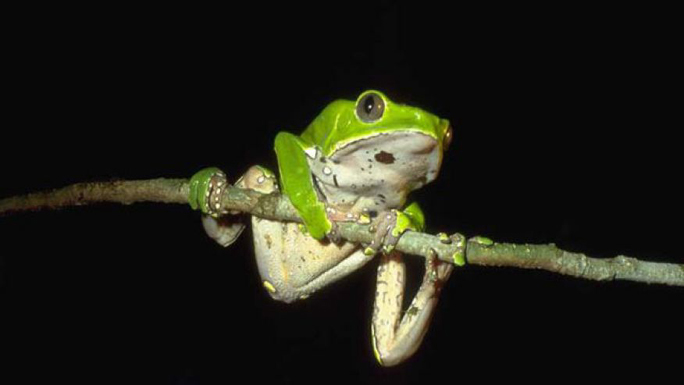
Sapo Frog
In the world of medicine, many animal and insect-derived drugs and treatments have been employed throughout time. Maggots, leeches, venomous insects and a variety of reptiles have been used medicinally. Among these, one animal medicine whose use persists today among Amazonian native people is sapo frog. Known by the latin name Phyllomedusa bicolor, this rainforest frog also goes by the tribal monikers Kambo, Kampo, and Sapo verde, and is found in Bolivia, Brazil, Colombia, Peru, Venezuela, and the Guianas.
Employed by native people throughout Amazonia to improve hunting skills by heightening sensory acuity, the use of sapo frog has enjoyed experimental use by non-native travelers for about thirty years as a rite of passage, for purposes of detoxification, or simply as a dare. First brought to the attention of non-natives by French missionary Constantin Tastevin in 1925, sapo gained initial interest of medical researchers in the 1950’s. By the 1980’s, researchers were filing patents on the peptides in this strange medicine. Today as many as 70 patents exist. As travelers venture further into rainforest areas, they have come across long-held traditions and novel therapies and rituals. The application of sapo frog, which has been a traditional agent of rainforest hunters since antiquity, provides a strange experience for those lured by its novel and harsh physical and mind-altering activity.
To prepare sapo frog, a large frog is hunted in the forest and captured alive. Though the frog is not harmed during the process of its use, it is certainly stressed and annoyed. The frog is staked to the ground, with each of its four limbs tied to sticks. Immobilized in a spread position, the frog produces an abundance of protective secretion from its skin. This secretion is scraped off of the frog, which is eventually set free greatly annoyed.
The skin of sapo frog appears to be a factory of complex, toxic, and psychoactive agents, at least seven different groups of which have been discovered and identified by chemists. Secretions of sapo frog contain a cocktail of vasoactive peptides, opioid peptides including dermorphin, and a peptide named adenoregulin. These agents act as powerful opioid agonists, and possess analgesic, antinociceptive and cataleptic activity. To translate this into plain language, the various compounds in sapo frog skin secretion increase the natural activity of the brain’s own opiates, block painful sensations, and cause a trance-like state accompanied by reduced motor control.
After the goo is scraped from the skin of the frog, it is applied to slender sticks known as Kampo sticks. Formerly these were held in the huts of shamans, but today it is possible for determined tourists to acquire them as well. I have even found them for sale online. When the sapo is applied, the person undergoing use sits still while as many as five small burns are made on one arm, with a slender burning stick. The burns are each about the size of the head of a small nail, and are just enough to produce small blisters. The blisters are scraped away, leaving open exposed capillaries in the skin. A prepared kampo stick is then moistened at its tip, usually with saliva, and applied to each of the small open burns. Then there is a waiting period.
As the peptides in the sapo secretion enter the bloodstream, the person begins to feel strange. There is a sense of lassitude, usually accompanied by gastrointestinal distress, typically resulting in vomiting. A pounding head and heart are common. In general, the symptoms of use are mostly unpleasant. After half an hour or more, the effects start to subside. Given these seemingly conditions, why would anyone choose to use sapo? This is somewhat of a no pain, no gain medicine. Sometime after the uncomfortable effects have worn off, the user feels increased strength and significantly sharper senses. In addition, the sapo reduces hunger and thirst.
For hunters stalking prey deep within the lush green Amazonian forest, any agent that enhances hearing and sight provides an obvious advantage for success. Detecting prey more easily, and being able to hike in the forest foregoing food and water, provide a hunting edge. But what about the use of sapo among non-natives? Many swear that it makes them feel terrific, and that the discomfort of use is outweighed by the eventual benefits. Whatever the case may be, sapo handily makes my list of strange remedies.

